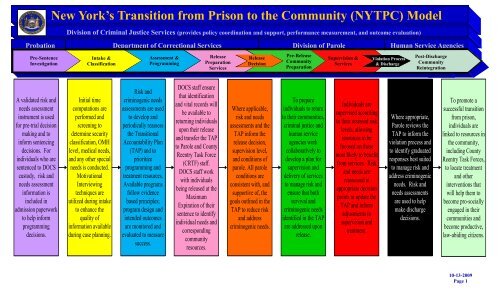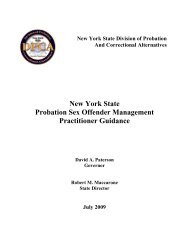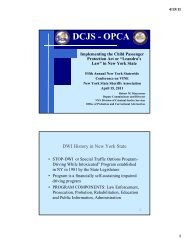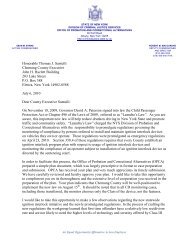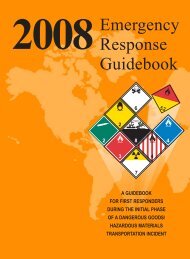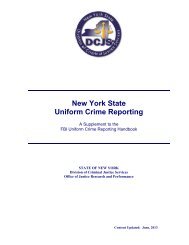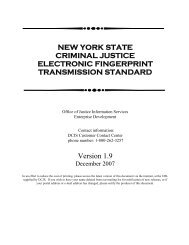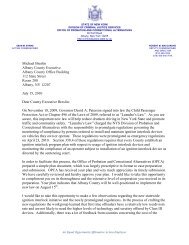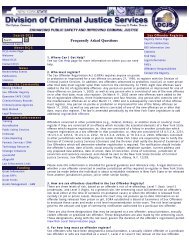New York's Transition from Prison to the Community (NYTPC) Model
New York's Transition from Prison to the Community (NYTPC) Model
New York's Transition from Prison to the Community (NYTPC) Model
- No tags were found...
Create successful ePaper yourself
Turn your PDF publications into a flip-book with our unique Google optimized e-Paper software.
<strong>New</strong> York’s <strong>Transition</strong> <strong>from</strong> <strong>Prison</strong> <strong>to</strong> <strong>the</strong> <strong>Community</strong> (<strong>NYTPC</strong>) <strong>Model</strong>Division of Criminal Justice Services (provides policy coordination and support, performance measurement, and outcome evaluation)Probation Department of Correctional Services Division of Parole Human Service AgenciesPre-Sentence Pre-Sentence Intake Intake & & Assessment Assessment Release &ReleasePre-ReleaseInvestigation Classification ProgrammingPreparationRelease ReleasePre-ReleaseSupervision & Violation ProcessInvestigationClassificationProgrammingPreparation<strong>Community</strong>ServicesDecisionDecision<strong>Community</strong>Preparation& Services Services & Discharge & DischargeServicesPreparationViolation ProcessPost-Discharge<strong>Community</strong>ReintegrationA validated risk andneeds assessmentinstrument is usedfor pre-trial decisionmaking and <strong>to</strong>inform sentencingdecisions. Forindividuals who aresentenced <strong>to</strong> DOCScus<strong>to</strong>dy, risk andneeds assessmentinformation isincluded inadmission paperwork<strong>to</strong> help informprogrammingdecisions.Initial timecomputations areperformed andscreening <strong>to</strong>determine securityclassification, OMHlevel, medical needs,and any o<strong>the</strong>r specialneeds is conducted.MotivationalInterviewingtechniques areutilized during intake<strong>to</strong> enhance <strong>the</strong>quality ofinformation availableduring case planning.Risk andcriminogenic needsassessments are used<strong>to</strong> develop andperiodically reassess<strong>the</strong> <strong>Transition</strong>alAccountability Plan(TAP) and <strong>to</strong>prioritizeprogramming andtreatment resources.Available programsfollow evidencebased principles;program design andintended outcomesare moni<strong>to</strong>red andevaluated <strong>to</strong> measuresuccess.DOCS staff ensurethat identificationand vital records willbe available <strong>to</strong>returning individualsupon <strong>the</strong>ir releaseand transfer <strong>the</strong> TAP<strong>to</strong> Parole and CountyReentry Task Force(CRTF) staff.DOCS staff workwith individualsbeing released at <strong>the</strong>MaximumExpiration of <strong>the</strong>irsentence <strong>to</strong> identifyindividual needs andcorrespondingcommunityresources.Where applicable,risk and needsassessments and <strong>the</strong>TAP inform <strong>the</strong>release decision,supervision level,and conditions ofparole. All paroleconditions areconsistent with, andsupportive of, <strong>the</strong>goals outlined in <strong>the</strong>TAP <strong>to</strong> reduce riskand addresscriminogenic needs.To prepareindividuals <strong>to</strong> return<strong>to</strong> <strong>the</strong>ir communities,criminal justice andhuman serviceagencies workcollaboratively <strong>to</strong>develop a plan forsupervision anddelivery of services<strong>to</strong> manage risk andensure that bothsurvival andcriminogenic needsidentified in <strong>the</strong> TAPare addressed uponrelease.Individuals aresupervised according<strong>to</strong> <strong>the</strong>ir assessed risklevels, allowingresources <strong>to</strong> befocused on thosemost likely <strong>to</strong> benefit<strong>from</strong> services. Riskand needs arereassessed atappropriate decisionpoints <strong>to</strong> update <strong>the</strong>TAP and informadjustments insupervision andtreatment.Where appropriate,Parole reviews <strong>the</strong>TAP <strong>to</strong> inform <strong>the</strong>violation process and<strong>to</strong> identify graduatedresponses best suited<strong>to</strong> manage risk andaddress criminogenicneeds. Risk andneeds assessmentsare used <strong>to</strong> helpmake dischargedecisions.To promote asuccessful transition<strong>from</strong> prison,individuals arelinked <strong>to</strong> resources in<strong>the</strong> community,including CountyReentry Task Forces,<strong>to</strong> locate treatmentand o<strong>the</strong>rinterventions thatwill help <strong>the</strong>m <strong>to</strong>become pro-sociallyengaged in <strong>the</strong>ircommunities andbecome productive,law-abiding citizens.10-13-2009Page 1
<strong>NYTPC</strong> Executive SummaryTPC BackgroundIn 2004, <strong>New</strong> York was one of eight states invited <strong>to</strong> participate in <strong>the</strong> National Institute of Corrections’ (NIC) <strong>Transition</strong> <strong>from</strong> <strong>Prison</strong> <strong>to</strong> <strong>the</strong> <strong>Community</strong> (TPC) initiative. The TPC initiative stresses collaborationamong criminal justice and human service agencies as well as <strong>the</strong> formation of strategic partnerships with local governments and service provider agencies <strong>to</strong> integrate evidence-based reentry policies and programs.Chaired by <strong>the</strong> Division of Criminal Justice Services, a multi-agency Statewide Offender Reentry Task Force was organized <strong>to</strong> implement <strong>the</strong> TPC model of reentry in <strong>New</strong> York. The Task Force developed a visionfor reentry in <strong>New</strong> York State and defined its mission in implementing TPC as follows:VisionA safer <strong>New</strong> York resulting <strong>from</strong> <strong>the</strong> successful transition of individuals <strong>from</strong> prison <strong>to</strong> living law-abiding and productive lives in <strong>the</strong>ir communities.MissionEstablishing a coordinated statewide system <strong>to</strong> accurately assess and respond <strong>to</strong> risks and needs, support individual accountability and reparation <strong>to</strong> victims and communities, promote selfsufficiencyand encourage family and community involvement in <strong>the</strong> returning individual’s success.<strong>New</strong> York <strong>Transition</strong> <strong>from</strong> <strong>Prison</strong> <strong>to</strong> <strong>the</strong> <strong>Community</strong> (<strong>NYTPC</strong>) <strong>Model</strong>With guidance <strong>from</strong> <strong>the</strong> NIC and <strong>the</strong> Center for Effective Public Policy, a sub-group of <strong>the</strong> Statewide Task Force has taken steps <strong>to</strong>ward <strong>the</strong> achievement of its vision through <strong>the</strong> development of <strong>the</strong> <strong>New</strong> York<strong>Transition</strong> <strong>from</strong> <strong>Prison</strong> <strong>to</strong> <strong>the</strong> <strong>Community</strong> (<strong>NYTPC</strong>) model. The <strong>NYTPC</strong> represents an ideal reentry system in <strong>New</strong> York State that has fully implemented each of <strong>the</strong> tenets of <strong>the</strong> TPC model and evidence-basedpractices. The model weaves <strong>to</strong>ge<strong>the</strong>r each of <strong>New</strong> York’s myriad reentry projects and initiatives in<strong>to</strong> a single, coordinated system of reentry and will serve as a blueprint for all future efforts. The <strong>NYTPC</strong> representsa new way of doing business that prioritizes interagency collaboration; promotes <strong>the</strong> seamless transition of individuals through each phase of reentry; engages each individual in <strong>the</strong>ir own transition plan and process;and fully incorporates evidence-based practices.Key Implications for <strong>New</strong> York State Reentry PartnersThe comprehensive <strong>NYTPC</strong> model assumes many partners and outlines numerous reentry stages and steps within each stage. The model is envisioned as <strong>the</strong> ideal reentry system in <strong>New</strong> York State and will requirelong-term commitment <strong>to</strong> operationalize. Some of <strong>the</strong> elements of <strong>the</strong> model have already been accomplished and fully implemented, o<strong>the</strong>rs are currently in progress by one or more reentry partners, while still o<strong>the</strong>rsare goals for <strong>New</strong> York’s reentry system in ei<strong>the</strong>r <strong>the</strong> short or <strong>the</strong> long term. The following are highlights of some of <strong>the</strong> key components of <strong>the</strong> <strong>NYTPC</strong> model once fully implemented.ProbationActuarial risk and needs assessment is used <strong>to</strong> inform pre-trial and sentencing decisionsDepartment of Correctional ServicesRisk and needs information is received <strong>from</strong> probation departments at intake for use in programming decisionsRisk and needs assessment is conducted periodically <strong>to</strong> appropriately prioritize programming and treatment resources<strong>Transition</strong> Accountability Plans are tailored <strong>to</strong> risk, needs and individual circumstances and are developed with returning individuals, routinely updated and shared with Parole staffStaff are trained in “motivational interviewing” techniques <strong>to</strong> solicit comprehensive case information and enhance motivation for initiating and maintaining behavior changes in returning individualsProgramming and treatment interventions are evidence-based, moni<strong>to</strong>red for implementation fidelity and evaluated on an ongoing basisDivision of ParoleParole Board uses actuarial risk and needs assessment <strong>to</strong> inform release decisionsParole conditions support <strong>the</strong> goals and address <strong>the</strong> criminogenic needs outlined in individual <strong>Transition</strong> Accountability PlansStaff are trained in “motivational interviewing” techniques <strong>to</strong> solicit comprehensive case information and enhance motivation for initiating and maintaining behavior changes in returning individuals<strong>Transition</strong> Accountability Planning with <strong>the</strong> returning individual is ongoingSupervision levels are based on risk with primary programming and treatment resources individually targeted <strong>to</strong>wards those who are high/medium riskA system of graduated responses based on actuarial risk and needs assessment is employed <strong>to</strong> respond <strong>to</strong> parole violations10-13-2009Page 2
<strong>NYTPC</strong> Executive Summary (page 2)Office of Mental Health, Office of Alcoholism and Substance Abuse Treatment and O<strong>the</strong>r Human Service PartnersAgencies work collaboratively <strong>to</strong> initiate timely access <strong>to</strong> public benefits and ensure that survival and stabilization needs will be met upon releaseAppropriate agencies are engaged in program and treatment delivery throughout <strong>the</strong> reentry process <strong>to</strong> ensure a comprehensive, integrated and evidence-based array of interventionsthat may not be possible by a single agency<strong>Transition</strong> Accountability Planning is a collaborative process involving multiple agencies<strong>Community</strong>-based programming and treatment is evidence-based and tailored <strong>to</strong> individual risk, needs and responsivity fac<strong>to</strong>rsCounty Reentry Task Forces engage pro-social supports in <strong>the</strong> natural communities of returning individualsTechnical Notes for Reading and Using this DocumentThe diagram in <strong>the</strong> header of <strong>the</strong> cover page is an adaptation of NIC’s TPC model <strong>to</strong> <strong>New</strong> York’s reentry system. The stacked rectangular blocks represent which partner is responsible for each stage of reentrywith, “<strong>New</strong> York’s <strong>Transition</strong> <strong>from</strong> <strong>Prison</strong> <strong>to</strong> <strong>the</strong> <strong>Community</strong> <strong>Model</strong>” unifying <strong>the</strong> entire process.Each of <strong>the</strong> multi-colored arrows in this diagram depicts one stage of <strong>the</strong> reentry process which flows seamlessly in<strong>to</strong> <strong>the</strong> next. The “Release Decision” and “Violation Process & Discharge” arrowsare portrayed differently <strong>to</strong> suggest that <strong>the</strong> point in time at which <strong>the</strong>y occur may fluctuate.The remainder of <strong>the</strong> cover page contains a summary description of each stage of <strong>the</strong> reentry process beginning with “Pre-Sentence Investigation” and ending with “Post-Discharge <strong>Community</strong> Reintegration.”Each stage of <strong>the</strong> reentry process is represented in <strong>the</strong> same color as in <strong>the</strong> header diagram. The following pages present enlarged flowcharts representing every step within each stage of <strong>the</strong> reentry process.A “Critical Components & Implementation Considerations” section accompanies each individual flow chart and contains footnotes pertinent <strong>to</strong> one or more of <strong>the</strong> steps in that flow chart. Footnotes identifiedby <strong>the</strong> same letter throughout <strong>the</strong> model are not unique but ra<strong>the</strong>r are repeated throughout <strong>the</strong> document. The footnotes may contain ei<strong>the</strong>r terminology definitions, descriptions of individual evidence-basedreentry practices or enumerations of one of <strong>the</strong> eight principles for effective interventions identified by NIC. These principles, listed in developmental order, are:Principle #1: Assess Actuarial Risk and Needs - Develop and maintain a complete system for <strong>the</strong> use of reliable and validated actuarial instruments <strong>to</strong> assess <strong>the</strong> risk and needs of returning individuals.Principle #2: Enhance Intrinsic Motivation: For lasting changes in behavior <strong>to</strong> occur, staff should relate <strong>to</strong> returning individuals in ways that will enhance intrinsic motivation (e.g. Motivational Interviewing).Principle #3: Target Interventions: Supervision and treatment resources should be prioritized for higher risk individuals; interventions must be targeted at criminogenic needs; and programmingshould be responsive <strong>to</strong> individual learning styles, gender, culture etc.Principle #4: Skill Train with Directed Practice: Use cognitive-behavioral treatment methods.Principle #5: Increase Positive Reinforcement: A ratio of four positive <strong>to</strong> every one negative reinforcement is optimal for promoting behavior changes in returning individuals.Principle #6: Engage Ongoing Support in Natural Communities: Realign and actively engage pro-social supports for returning individuals in <strong>the</strong>ir own communities.Principle #7: Measure Relevant Processes/Practices: A formal and valid mechanism for measuring outcomes is <strong>the</strong> foundation of evidence-based practice.Principle #8: Provide Measurement Feedback: Once a mechanism for performance measurement and outcome evaluation is in place, <strong>the</strong> information gleaned must be used <strong>to</strong> inform policies and programming.10-13-2009Page 3
Pre-Sentence InvestigationUtilize condensedversion of a validated,actuarial risk and needsassessment instrumentfor pre-trial decisionmakingAUtilize validated,actuarial risk and needsassessment instrumentas part of pre-sentenceinvestigation process <strong>to</strong>inform sentencingdecisionASentenceNot DOCSDOCSInclude risk andneeds assessmentresults as part ofDOCS admissionpaperworkIntake &ClassificationNot TPC trackCRITICAL COMPONENTS & IMPLEMENTATION CONSIDERATIONSA) NIC Principle#1: Assess Actuarial Risk and NeedsRisk and criminogenic needs should be assessed using a “reliable” instrument that has been validated on a similar population.It is important <strong>to</strong> consider whe<strong>the</strong>r <strong>the</strong> instrument is valid for <strong>the</strong> gender of <strong>the</strong> population being assessed. A validated, gender responsive instrument should be used <strong>to</strong> assess female populations.Because risk and needs can be dynamic, assessment should be conducted on an ongoing basis <strong>to</strong> inform critical decisions and case management plans.Assessments are most reliable and valid when staff are formally trained <strong>to</strong> administer <strong>to</strong>ols.Assessment <strong>to</strong>ols should be supported by sufficiently detailed written procedures.10-13-2009Page 4
Intake & ClassificationViolationProcessPSIIntakeBClassificationBDOCSProgramming &AssessmentFPMS pre-populatedwith pertinentactuarial risk andneeds assessmentdata <strong>from</strong> PSIConduct needsreview andassessment,including chemicaldependency,education andvocationTimecomputationDocumentprocessingSecurityclassificationWith OMHMental Heal<strong>the</strong>valuationMedicalevaluationSpecial needsevaluationCRITICAL COMPONENTS & IMPLEMENTATION CONSIDERATIONSB) NIC Principle #2: Enhance Intrinsic Motivation“Motivational interviewing” techniques should be utilized by intake staff <strong>to</strong> enhance <strong>the</strong> quality of information ga<strong>the</strong>red for use in case planning.“Motivational interviewing” techniques should be utilized by programming staff <strong>to</strong> reduce ambivalence about behavior change and <strong>to</strong> enhance motivation for initiating and maintaining such change.“Motivational interviewing” is a client-centered, directive <strong>the</strong>rapy focused on increasing motivation by resolving ambivalence about behavior change.Staff should be trained in motivational interviewing.10-13-2009Page 5
DOCS Programming & AssessmentSupervision/cus<strong>to</strong>dy and control trackHIGHEST RISKIWith OMH and OASASIntake &ClassificationUse validated, actuarialinstrument <strong>to</strong> assessrisk of future criminalbehavior andcriminogenic needsARisk level?HIGH/MEDIUM RISKPrioritize primaryprogramming and treatmentresourcesWork with reenteringindividual <strong>to</strong> establish<strong>Transition</strong> AccountabilityPlan (TAP)JDOCSProgramming& Assessment(Page 2)LOWEST RISKStabilization trackCRITICAL COMPONENTS & IMPLEMENTATION CONSIDERATIONSA) NIC Principle#1: Assess Actuarial Risk and NeedsRisk and criminogenic needs should be assessed using a “reliable” instrument that has been validated on a similar population.It is important <strong>to</strong> consider whe<strong>the</strong>r <strong>the</strong> instrument is valid for <strong>the</strong> gender of <strong>the</strong> population being assessed. A validated, gender responsive instrument should be used <strong>to</strong> assess female populations.Because risk and needs can be dynamic, assessment should be conducted on an ongoing basis <strong>to</strong> inform critical decisions and case management plans.Assessments are most reliable and valid when staff are formally trained <strong>to</strong> administer <strong>to</strong>ols.Assessment <strong>to</strong>ols should be supported by sufficiently detailed written procedures.I) Highest RiskThis is <strong>the</strong> subset of individuals with risk characteristics including: preda<strong>to</strong>ry nature, significant his<strong>to</strong>ry of violent crime, no remorse, no treatment amenability, and low motivation.If accessed on <strong>the</strong> Hare PCL-R, <strong>the</strong>se individuals would score as psychopathic.J) <strong>Transition</strong> Accountability Plan (TAP)The TAP should be a comprehensive, dynamic and individualized case management plan developed with each reentering person.Staff should be trained <strong>to</strong> use Motivational Interviewing techniques, which will help <strong>to</strong> engage individuals in creating <strong>the</strong> TAP and enhance <strong>the</strong>ir intrinsic motivation.The reentering individual should be engaged in <strong>the</strong> process <strong>to</strong> increase motivation and commitment <strong>to</strong> <strong>the</strong> plan.The TAP should have a strength-based focus.The TAP is a formal agreement outlining <strong>the</strong> responsibilities of all stakeholders.The TAP should be based on individual risk and needs assessment, with programming resources targeted for those most likely <strong>to</strong> benefit.The TAP will serve as a mechanism <strong>to</strong> facilitate communication and information sharing within and across agencies and amongst stakeholders.When appropriate, and as needed, <strong>the</strong> TAP development process should collaboratively involve Criminal Justice agencies, OMH, OASAS, and o<strong>the</strong>r human service agencies.10-13-2009Page 6
DOCS Programming & Assessment (page 2)ReleaseDecisionReleasePreparationServicesDOCSProgramming &AssessmentWith OMH and OASASDeliver programming thatis based on scientificevidence of recidivismreduction and, as outlinedin <strong>the</strong> TAP, addressesindividuals’ identifiedcriminogenic needsMoni<strong>to</strong>r fidelity <strong>to</strong>program designGEvaluateprogramming forsuccess inachieving desiredoutcomes GOMHUse validated, actuarialinstrument <strong>to</strong> reassess risk offuture criminal behavior andcriminogenic needs atappropriate intervals/decisionpointsRisk level?HIGHEST RISKISupervision/cus<strong>to</strong>dy and control trackHIGH/MEDIUM RISKPrioritize primaryprogramming and treatmentresourcesWith OMH and OASASWork with reenteringindividual <strong>to</strong>update TAPJB, C, D, E, GALOWEST RISKStabilization trackCRITICAL COMPONENTS & IMPLEMENTATION CONSIDERATIONSA) NIC Principle#1: Assess Actuarial Risk and NeedsRisk and criminogenic needs should be assessed using a “reliable” instrument that has been validated on a similar population.It is important <strong>to</strong> consider whe<strong>the</strong>r <strong>the</strong> instrument is valid for <strong>the</strong> gender of <strong>the</strong> population being assessed. A validated, gender responsive instrument should be used <strong>to</strong> assess female populations.Because risk and needs can be dynamic, assessment should be conducted on an ongoing basis <strong>to</strong> inform critical decisions and case management plans.Assessments are most reliable and valid when staff are formally trained <strong>to</strong> administer <strong>to</strong>ols.Assessment <strong>to</strong>ols should be supported by sufficiently detailed written procedures.B) NIC Principle #2: Enhance Intrinsic Motivation“Motivational interviewing” techniques should be utilized by intake staff <strong>to</strong> enhance <strong>the</strong> quality of information ga<strong>the</strong>red for use in case planning.“Motivational interviewing” techniques should be utilized by programming staff <strong>to</strong> reduce ambivalence about behavior change and <strong>to</strong> enhance motivation for initiating and maintaining such change.“Motivational interviewing” is a client-centered, directive <strong>the</strong>rapy focused on increasing motivation by resolving ambivalence about behavior change.Staff should be trained in motivational interviewing.C) NIC Principle #3: Target Programming and Interventions Based on Risk, Need and Responsivity PrinciplesCore reentry programming must be prioritized for individuals who are at high/medium risk <strong>to</strong> reoffend.Dosage/level of treatment should be matched <strong>to</strong> level of risk.Core reentry programming must assess and target identified criminogenic needs (i.e. antisocial attitudes, values and beliefs; criminal personality; low self-control; criminal peers; troubled family fac<strong>to</strong>rs;low levels of educational, vocational and financial achievement; risky use of leisure and recreation time; and substance abuse).Core reentry programming must be tailored <strong>to</strong> meet individual learning style, culture, gender, motivational stage, developmental stage and abilities.Core reentry programming for female offenders must be gender responsive (e.g. strength-based, relationship-based, child-centered and trauma-informed).Those delivering programming/interventions must have appropriate skills and be well-trained.Engage OMH, OASAS, and o<strong>the</strong>r human service partners, where appropriate, in program delivery <strong>to</strong> ensure a comprehensive, integrated and evidence-based array of programming that may notbe possible by a single agency.10-13-2009Page 7
DOCS Programming & Assessment (page 3)CRITICAL COMPONENTS & IMPLEMENTATION CONSIDERATIONS (continued)D) NIC Principle #4: Skill Train with Directed PracticePrograms should not simply teach skills, but <strong>the</strong>y should be role-played and <strong>the</strong> resulting pro-social attitudes and behaviors positively reinforced.Programs should introduce a variety of cognitive skills including, problem-solving, interpersonal skills, assertiveness, decision-making and emotional regulation and management.Social learning methods such as pro-social modeling and appropriate use of reinforcement and disapproval, should be used <strong>to</strong> influence behavior.Staff must be well-trained and understand anti-social thinking, social learning and appropriate communication techniques.E) NIC Principle #5: Increase Positive Reinforcement (Extrinsic Motivation)In order <strong>to</strong> achieve sustained behavioral change, research indicates that a ratio of four positive <strong>to</strong> every one negative reinforcement is optimal.With exposure <strong>to</strong> clear rules that are consistently and swiftly enforced with appropriate graduated responses, individuals will tend <strong>to</strong> comply in <strong>the</strong> direction of <strong>the</strong> most rewards and least punishments.G) Principles #7 and #8: Measure Relevant Processes/Practices and Provide Measurement FeedbackReview existing programs <strong>to</strong> determine whe<strong>the</strong>r <strong>the</strong>y are based on scientific evidence of effectiveness in attaining desired outcomes (start by ensuring that programs are <strong>the</strong>oretically sound;next review program evaluation data).Within organizations and programs, evaluate fidelity <strong>to</strong> program design, service delivery principles, and outcomes <strong>to</strong> build accountability and maintain integrity.Evaluate and modify processes and practices as needed based on evaluation results.I) Highest RiskThis is <strong>the</strong> subset of individuals with risk characteristics including: preda<strong>to</strong>ry nature, significant his<strong>to</strong>ry of violent crime, no remorse, no treatment amenability, and low motivation.If accessed on <strong>the</strong> Hare PCL-R, <strong>the</strong>se individuals would score as psychopathic.J) <strong>Transition</strong> Accountability Plan (TAP)The TAP should be a comprehensive, dynamic and individualized case management plan developed with each reentering person.Staff should be trained <strong>to</strong> use Motivational Interviewing techniques, which will help <strong>to</strong> engage individuals in creating <strong>the</strong> TAP and enhance <strong>the</strong>ir intrinsic motivation.The reentering individual should be engaged in <strong>the</strong> process <strong>to</strong> increase motivation and commitment <strong>to</strong> <strong>the</strong> plan.The TAP should have a strength-based focus.The TAP is a formal agreement outlining <strong>the</strong> responsibilities of all stakeholders.The TAP should be based on individual risk and needs assessment, with programming resources targeted for those most likely <strong>to</strong> benefit.The TAP will serve as a mechanism <strong>to</strong> facilitate communication and information sharing within and across agencies and amongst stakeholders.When appropriate, and as needed, <strong>the</strong> TAP development process should collaboratively involve Criminal Justice agencies, OMH, OASAS, and o<strong>the</strong>r human service agencies.10-13-2009Page 8
Release Preparation ServicesDOCSProgramming &Assessment(Page 2)With Human Service partnersEnsure that appropriateidentification and o<strong>the</strong>rvital records areavailable <strong>to</strong> returningindividual upon releaseKUnder ParoleSupervision in<strong>Community</strong>?Yes, Parole SupervisionNo, METransfer TAP<strong>to</strong> facilityparole staffDOCS staff conduct exitinterview(s) withreturning individual <strong>to</strong>identify and discuss needareas and communityresourcesBCRTF?NoCRTF?NoYesYesShare TAPwith CountyReentry TaskForceRealign andactively engage prosocialsupport innatural communityShare TAPwith CountyReentry TaskForceFRealign andactively engage prosocialsupport innatural communityFConnectreturningindividual withCRTF FConnectreturningindividual withCRTF FReleaseDecisionPost-Discharge<strong>Community</strong>ReintegrationCRITICAL COMPONENTS & IMPLEMENTATION CONSIDERATIONSB) NIC Principle #2: Enhance Intrinsic Motivation“Motivational interviewing” techniques should be utilized by intake staff <strong>to</strong> enhance <strong>the</strong> quality of information ga<strong>the</strong>red for use in case planning.“Motivational interviewing” techniques should be utilized by programming staff <strong>to</strong> reduce ambivalence about behavior change and <strong>to</strong> enhance motivation for initiating and maintaining such change.“Motivational interviewing” is a client-centered, directive <strong>the</strong>rapy focused on increasing motivation by resolving ambivalence about behavior change.Staff should be trained in motivational interviewing.F) NIC Principle #6: Engage On-going Pro-social Support in Natural CommunitiesActively recruit pro-social family members, spouses and supportive o<strong>the</strong>rs in <strong>the</strong> individual’s immediate environment <strong>to</strong> help reinforce positive behavior.Realign and actively engage pro-social men<strong>to</strong>rs and models for returning individuals in <strong>the</strong>ir communities.K) Survival and Stabilization NeedsLink vital records (e.g. birth certificate, Social Security card and non-driver’s ID) with TAP <strong>to</strong> ensure information sharing and transmission of documents.Work collaboratively with human service agencies involved in addressing survival and stabilization needs and providing entitlements.10-13-2009Page 9
Release DecisionReleasePreparationServicesDiscretionary Parole Board DecisionDOCSProgramming &Assessment(Page 2)Releasemechanism?Presumptive ReleaseUse validated, actuarialinstrument <strong>to</strong> reassessrisk of future criminalbehavior andcriminogenic needs <strong>to</strong>inform releasedecision AReview TAP <strong>to</strong>inform releasedecision and updateaccordinglyJNORelease?YESPre-Release<strong>Community</strong>PreparationConditional Release by Operation of LawUse validated, actuarialinstrument <strong>to</strong> reassessrisk of future criminalbehavior andcriminogenic needs <strong>to</strong>determine supervisionlevel and paroleconditions AReview TAP <strong>to</strong>determinesupervision level andparole conditionsand updateaccordingly JImpose parole conditionsthat are consistent with,and support <strong>the</strong> goals outlinedin <strong>the</strong> TAP, such that individuals’identified criminogenic needscan be addressedCRITICAL COMPONENTS & IMPLEMENTATION CONSIDERATIONSA) NIC Principle#1: Assess Actuarial Risk and NeedsRisk and criminogenic needs should be assessed using a “reliable” instrument that has been validated on a similar population.It is important <strong>to</strong> consider whe<strong>the</strong>r <strong>the</strong> instrument is valid for <strong>the</strong> gender of <strong>the</strong> population being assessed. A validated, gender responsive instrument should be used <strong>to</strong> assess female populations.Because risk and needs can be dynamic, assessment should be conducted on an ongoing basis <strong>to</strong> inform critical decisions and case management plans.Assessments are most reliable and valid when staff are formally trained <strong>to</strong> administer <strong>to</strong>ols.Assessment <strong>to</strong>ols should be supported by sufficiently detailed written procedures.J) <strong>Transition</strong> Accountability Plan (TAP)The TAP should be a comprehensive, dynamic and individualized case management plan developed with each reentering person.Staff should be trained <strong>to</strong> use Motivational Interviewing techniques, which will help <strong>to</strong> engage individuals in creating <strong>the</strong> TAP and enhance <strong>the</strong>ir intrinsic motivation.The reentering individual should be engaged in <strong>the</strong> process <strong>to</strong> increase motivation and commitment <strong>to</strong> <strong>the</strong> plan.The TAP should have a strength-based focus.The TAP is a formal agreement outlining <strong>the</strong> responsibilities of all stakeholders.The TAP should be based on individual risk and needs assessment, with programming resources targeted for those most likely <strong>to</strong> benefit.The TAP will serve as a mechanism <strong>to</strong> facilitate communication and information sharing within and across agencies and amongst stakeholders.When appropriate, and as needed, <strong>the</strong> TAP development process should collaboratively involve Criminal Justice agencies, OMH, OASAS, and o<strong>the</strong>r human service agencies.10-13-2009Page 10
Pre-Release <strong>Community</strong> PreparationMaximum supervision and control trackHIGHEST RISKReleaseDecisionIRisk level?HIGH/MEDIUM RISKPrioritize primaryprogramming and treatment resourcesWith OMH and OASASUtilize a collaborative,mulit-agency process <strong>to</strong>update <strong>the</strong> <strong>Transition</strong>Accountability Plan(TAP) for <strong>the</strong>community with <strong>the</strong>reentering individualJWith Human Service partnersInitiate access <strong>to</strong> publicbenefits and coordinateplanning with appropriatestate and local humanservice agencies <strong>to</strong> ensurethat survival needs,especially those identifiedin <strong>the</strong> TAP as critical <strong>to</strong>managing risk, will be metupon release KFacility parolenotifies field ofpertinent TAPcomponents<strong>Community</strong>Preparation ProcessField paroleverifies and/ormodifies pertinentTAP componentsSupervision& ServicesLOWEST RISKStabilization trackCRITICAL COMPONENTS & IMPLEMENTATION CONSIDERATIONSI) Highest RiskThis is <strong>the</strong> subset of individuals with risk characteristics including: preda<strong>to</strong>ry nature, significant his<strong>to</strong>ry of violent crime, no remorse, no treatment amenability, and low motivation.If accessed on <strong>the</strong> Hare PCL-R, <strong>the</strong>se individuals would score as psychopathic.J) <strong>Transition</strong> Accountability Plan (TAP)The TAP should be a comprehensive, dynamic and individualized case management plan developed with each reentering person.Staff should be trained <strong>to</strong> use Motivational Interviewing techniques, which will help <strong>to</strong> engage individuals in creating <strong>the</strong> TAP and enhance <strong>the</strong>ir intrinsic motivation.The reentering individual should be engaged in <strong>the</strong> process <strong>to</strong> increase motivation and commitment <strong>to</strong> <strong>the</strong> plan.The TAP should have a strength-based focus.The TAP is a formal agreement outlining <strong>the</strong> responsibilities of all stakeholders.The TAP should be based on individual risk and needs assessment, with programming resources targeted for those most likely <strong>to</strong> benefit.The TAP will serve as a mechanism <strong>to</strong> facilitate communication and information sharing within and across agencies and amongst stakeholders.When appropriate, and as needed, <strong>the</strong> TAP development process should collaboratively involve Criminal Justice agencies, OMH, OASAS, and o<strong>the</strong>r human service agencies.K) Survival and Stabilization NeedsLink vital records (e.g.; birth certificate, Social Security card and non-driver’s ID) with TAP <strong>to</strong> ensure information sharing and transmission of documents.Work collaboratively with outside agencies involved in addressing survival and stabilization needs and providing entitlements.10-13-2009Page 11
Supervision & ServicesMaximum supervision and control trackPre-Release<strong>Community</strong>PreparationHIGHEST RISKISuperviseindividualsaccording <strong>to</strong> risklevelLOWEST RISKHIGH/MEDIUMRISKMaximum supervisionand control trackCollaboratively case manageand moni<strong>to</strong>r parolees withCounty Reentry Task Forces(CRTFs) where availableStabilization trackLHIGHEST RISKIWith Human Service partnersBroker access <strong>to</strong>public benefits andaddress survivalneedsKHIGH/MEDIUMRISKWith OMH and OASASPrioritize provision or referral<strong>to</strong> interventions that are basedon scientific evidence ofrecidivism reduction and, asoutlined in <strong>the</strong> TAP, addressindividuals’ identifiedcriminogenic needsB, C, D, E, GUse a validated,actuarial instrument<strong>to</strong> reassess risk offuture criminalbehavior andcriminogenic needsat appropriateintervals/decisionpointsARisk level?HIGHEST RISKILOWEST RISKMaximum supervision and control trackHIGH/MEDIUM RISKPrioritize primary programmingand treatment resourcesWith OMH and OASASWork withreturningindividual <strong>to</strong>update TAPJViolationProcess &DischargeLOWEST RISKStabilization trackStabilization trackCRITICAL COMPONENTS & IMPLEMENTATION CONSIDERATIONSA) NIC Principle#1: Assess Actuarial Risk and NeedsRisk and criminogenic needs should be assessed using a “reliable” instrument that has been validated on a similar population.It is important <strong>to</strong> consider whe<strong>the</strong>r <strong>the</strong> instrument is valid for <strong>the</strong> gender of <strong>the</strong> population being assessed. A validated, gender responsive instrument should be used <strong>to</strong> assess female populations.Because risk and needs can be dynamic, assessment should be conducted on an ongoing basis <strong>to</strong> inform critical decisions and case management plans.Assessments are most reliable and valid when staff are formally trained <strong>to</strong> administer <strong>to</strong>ols.Assessment <strong>to</strong>ols should be supported by sufficiently detailed written procedures.B) NIC Principle #2: Enhance Intrinsic Motivation“Motivational interviewing” techniques should be utilized by intake staff <strong>to</strong> enhance <strong>the</strong> quality of information ga<strong>the</strong>red for use in case planning.“Motivational interviewing” techniques should be utilized by programming staff <strong>to</strong> reduce ambivalence about behavior change and <strong>to</strong> enhance motivation for initiating and maintaining such change.“Motivational interviewing” is a client-centered, directive <strong>the</strong>rapy focused on increasing motivation by resolving ambivalence about behavior change.Staff should be trained in motivational interviewing.C) NIC Principle #3: Target Programming and Interventions Based on Risk, Need and Responsivity PrinciplesCore reentry programming must be prioritized for individuals who are at high/medium risk <strong>to</strong> reoffend.Dosage/level of treatment should be matched <strong>to</strong> level of risk.Core reentry programming must assess and target identified criminogenic needs (i.e. antisocial attitudes, values and beliefs; criminal personality; low self-control; criminal peers; troubled family fac<strong>to</strong>rs;low levels of educational, vocational and financial achievement; risky use of leisure and recreation time; and substance abuse).Core reentry programming must be tailored <strong>to</strong> meet individual learning style, culture, gender, motivational stage, developmental stage and abilities.Core reentry programming for female offenders must be gender responsive (e.g. strength-based, relationship-based, child-centered and trauma-informed).Those delivering programming/interventions must have appropriate skills and be well-trained.Engage OMH, OASAS, and o<strong>the</strong>r human service partners, where appropriate, in program delivery <strong>to</strong> ensure a comprehensive, integrated and evidence-based array of programming that may notbe possible by a single agency. 10-13-2009Page 12
Supervision & Services (page 2)CRITICAL COMPONENTS & IMPLEMENTATION CONSIDERATIONS (continued)D) NIC Principle #4: Skill Train with Directed PracticePrograms should not simply teach skills, but <strong>the</strong>y should be role-played and <strong>the</strong> resulting pro-social attitudes and behaviors positively reinforced.Programs should introduce a variety of cognitive skills including, problem-solving, interpersonal skills, assertiveness, decision-making and emotional regulation and management.Social learning methods such as pro-social modeling and appropriate use of reinforcement and disapproval, should be used <strong>to</strong> influence behavior.Staff must be well-trained and understand anti-social thinking, social learning and appropriate communication techniques.E) NIC Principle #5: Increase Positive Reinforcement (Extrinsic Motivation)In order <strong>to</strong> achieve sustained behavioral change, research indicates that a ratio of four positive <strong>to</strong> every one negative reinforcement is optimal.With exposure <strong>to</strong> clear rules that are consistently and swiftly enforced with appropriate graduated responses, individuals will tend <strong>to</strong> comply in <strong>the</strong> direction of <strong>the</strong> most rewards and least punishments.G) Principles #7 and #8: Measure Relevant Processes/Practices and Provide Measurement FeedbackReview existing programs <strong>to</strong> determine whe<strong>the</strong>r <strong>the</strong>y are based on scientific evidence of effectiveness in attaining desired outcomes (start by ensuring that programs are <strong>the</strong>oretically sound;next review program evaluation data).Within organizations and programs, evaluate fidelity <strong>to</strong> program design, service delivery principles, and outcomes <strong>to</strong> build accountability and maintain integrity.Evaluate and modify processes and practices as needed based on evaluation results.I) Highest RiskThis is <strong>the</strong> subset of individuals with risk characteristics including: preda<strong>to</strong>ry nature, significant his<strong>to</strong>ry of violent crime, no remorse, no treatment amenability, and low motivation.If accessed on <strong>the</strong> Hare PCL-R, <strong>the</strong>se individuals would score as psychopathic.J) <strong>Transition</strong> Accountability Plan (TAP)The TAP should be a comprehensive, dynamic and individualized case management plan developed with each reentering person.Staff should be trained <strong>to</strong> use Motivational Interviewing techniques, which will help <strong>to</strong> engage individuals in creating <strong>the</strong> TAP and enhance <strong>the</strong>ir intrinsic motivation.The reentering individual should be engaged in <strong>the</strong> process <strong>to</strong> increase motivation and commitment <strong>to</strong> <strong>the</strong> plan.The TAP should have a strength-based focus.The TAP is a formal agreement outlining <strong>the</strong> responsibilities of all stakeholders.The TAP should be based on individual risk and needs assessment, with programming resources targeted for those most likely <strong>to</strong> benefit.The TAP will serve as a mechanism <strong>to</strong> facilitate communication and information sharing within and across agencies and amongst stakeholders.When appropriate, and as needed, <strong>the</strong> TAP development process should collaboratively involve Criminal Justice agencies, OMH, OASAS, and o<strong>the</strong>r human service agencies.K) Survival and Stabilization NeedsLink vital records (e.g.; birth certificate, Social Security card and non-driver’s ID) with TAP <strong>to</strong> ensure information sharing and transmission of documents.Work collaboratively with outside agencies involved in addressing survival and stabilization needs and providing entitlements.L) Supervision of High Risk IndividualsFor high risk individuals, 40-70% of free time should be clearly occupied with pro-social activities and programming during <strong>the</strong> initial three <strong>to</strong> nine months post-release.10-13-2009Page 13
Violation Process and DischargeSupervision &ServicesWith OMH and OASASIntake &ClassificationPossible paroleviolationbehavior?YESReview TAP<strong>to</strong> informviolationprocessBased on risk andneeds assessment,employ a system ofgraduated responses<strong>to</strong> address paroleviolations EProvide or refer <strong>to</strong> treatmentinterventions that are basedon scientific evidence ofrecidivism reduction and, asoutlined in <strong>the</strong> TAP,addresses individuals’identified criminogenic needsWork withindividual<strong>to</strong> updateTAPJNOReturn <strong>to</strong>DOCS?YESNOB, C, D,E, GContinue <strong>to</strong>implementTAP untildischargeUse validated, actuarialinstrument <strong>to</strong> reassessrisk of future criminalbehavior andcriminogenic needs <strong>to</strong>make dischargedecisionAConduct exitinterview(s) withreturning individual<strong>to</strong> identify anddiscuss criminogenicneed areas andcommunity resourcesBPost-Discharge<strong>Community</strong>ReintegrationCRITICAL COMPONENTS & IMPLEMENTATION CONSIDERATIONSA) NIC Principle#1: Assess Actuarial Risk and NeedsRisk and criminogenic needs should be assessed using a “reliable” instrument that has been validated on a similar population.It is important <strong>to</strong> consider whe<strong>the</strong>r <strong>the</strong> instrument is valid for <strong>the</strong> gender of <strong>the</strong> population being assessed. A validated, gender responsive instrument should be used <strong>to</strong> assess female populations.Because risk and needs can be dynamic, assessment should be conducted on an ongoing basis <strong>to</strong> inform critical decisions and case management plans.Assessments are most reliable and valid when staff are formally trained <strong>to</strong> administer <strong>to</strong>ols.Assessment <strong>to</strong>ols should be supported by sufficiently detailed written procedures.B) NIC Principle #2: Enhance Intrinsic Motivation“Motivational interviewing” techniques should be utilized by intake staff <strong>to</strong> enhance <strong>the</strong> quality of information ga<strong>the</strong>red for use in case planning.“Motivational interviewing” techniques should be utilized by programming staff <strong>to</strong> reduce ambivalence about behavior change and <strong>to</strong> enhance motivation for initiating and maintaining such change.“Motivational interviewing” is a client-centered, directive <strong>the</strong>rapy focused on increasing motivation by resolving ambivalence about behavior change.Staff should be trained in motivational interviewing.10-13-2009Page 14
Violation Process and Discharge (page 2)CRITICAL COMPONENTS & IMPLEMENTATION CONSIDERATIONS (continued)C) NIC Principle #3: Target Programming and Interventions Based on Risk, Need and Responsivity PrinciplesCore reentry programming must be prioritized for individuals who are at high/medium risk <strong>to</strong> reoffend.Dosage/level of treatment should be matched <strong>to</strong> level of risk.Core reentry programming must assess and target identified criminogenic needs (i.e. antisocial attitudes, values and beliefs; criminal personality; low self-control; criminal peers; troubled family fac<strong>to</strong>rs;low levels of educational, vocational and financial achievement; risky use of leisure and recreation time; and substance abuse).Core reentry programming must be tailored <strong>to</strong> meet individual learning style, culture, gender, motivational stage, developmental stage and abilities.Core reentry programming for female offenders must be gender responsive (e.g. strength-based, relationship-based, child-centered and trauma-informed).Those delivering programming/interventions must have appropriate skills and be well-trained.Engage OMH, OASAS, and o<strong>the</strong>r human service partners, where appropriate, in program delivery <strong>to</strong> ensure a comprehensive, integrated and evidence-based array of programming that may not be possible by asingle agency.D) NIC Principle #4: Skill Train with Directed PracticePrograms should not simply teach skills, but <strong>the</strong>y should be role-played and <strong>the</strong> resulting pro-social attitudes and behaviors positively reinforced.Programs should introduce a variety of cognitive skills including, problem-solving, interpersonal skills, assertiveness, decision-making and emotional regulation and management.Social learning methods such as pro-social modeling and appropriate use of reinforcement and disapproval, should be used <strong>to</strong> influence behavior.Staff must be well-trained and understand anti-social thinking, social learning and appropriate communication techniques.E) NIC Principle #5: Increase Positive Reinforcement (Extrinsic Motivation)In order <strong>to</strong> achieve sustained behavioral change, research indicates that a ratio of four positive <strong>to</strong> every one negative reinforcement is optimal.With exposure <strong>to</strong> clear rules that are consistently and swiftly enforced with appropriate graduated responses, individuals will tend <strong>to</strong> comply in <strong>the</strong> direction of <strong>the</strong> most rewards and least punishments.G) Principles #7 and #8: Measure Relevant Processes/Practices and Provide Measurement FeedbackReview existing programs <strong>to</strong> determine whe<strong>the</strong>r <strong>the</strong>y are based on scientific evidence of effectiveness in attaining desired outcomes (start by ensuring that programs are <strong>the</strong>oretically sound;next review program evaluation data).Within organizations and programs, evaluate fidelity <strong>to</strong> program design, service delivery principles, and outcomes <strong>to</strong> build accountability and maintain integrity.Evaluate and modify processes and practices as needed based on evaluation results.J) <strong>Transition</strong> Accountability Plan (TAP)The TAP should be a comprehensive, dynamic and individualized case management plan developed with each reentering person.Staff should be trained <strong>to</strong> use Motivational Interviewing techniques, which will help <strong>to</strong> engage individuals in creating <strong>the</strong> TAP and enhance <strong>the</strong>ir intrinsic motivation.The reentering individual should be engaged in <strong>the</strong> process <strong>to</strong> increase motivation and commitment <strong>to</strong> <strong>the</strong> plan.The TAP should have a strength-based focus.The TAP is a formal agreement outlining <strong>the</strong> responsibilities of all stakeholders.The TAP should be based on individual risk and needs assessment, with programming resources targeted for those most likely <strong>to</strong> benefit.The TAP will serve as a mechanism <strong>to</strong> facilitate communication and information sharing within and across agencies and amongst stakeholders.When appropriate, and as needed, <strong>the</strong> TAP development process should collaboratively involve Criminal Justice agencies, OMH, OASAS, and o<strong>the</strong>r human service agencies.10-13-2009Page 15
Post-Discharge <strong>Community</strong> ReintegrationWith OMH and OASASViolationProcess &DischargeReleasePreparationServicesLink formerlyincarcerated person withCRTF or communityresourcesFRefer <strong>to</strong> treatment and/or o<strong>the</strong>rinterventions that are based onscientific evidence of recidivismreduction and, as outlined in <strong>the</strong>TAP, address individuals’identified criminogenic needsB, C, D, E, GEngage pro-socialsupport in naturalcommunitiesFLaw abiding andproductive citizenCRITICAL COMPONENTS & IMPLEMENTATION CONSIDERATIONSB) NIC Principle #2: Enhance Intrinsic Motivation“Motivational interviewing” techniques should be utilized by intake staff <strong>to</strong> enhance <strong>the</strong> quality of information ga<strong>the</strong>red for use in case planning.“Motivational interviewing” techniques should be utilized by programming staff <strong>to</strong> reduce ambivalence about behavior change and <strong>to</strong> enhance motivation for initiating and maintaining such change.“Motivational interviewing” is a client-centered, directive <strong>the</strong>rapy focused on increasing motivation by resolving ambivalence about behavior change.Staff should be trained in motivational interviewing.C) NIC Principle #3: Target Programming and Interventions Based on Risk, Need and Responsivity PrinciplesCore reentry programming must be prioritized for individuals who are at high/medium risk <strong>to</strong> reoffend.Dosage/level of treatment should be matched <strong>to</strong> level of risk.Core reentry programming must assess and target identified criminogenic needs (i.e. antisocial attitudes, values and beliefs; criminal personality; low self-control; criminal peers; troubled family fac<strong>to</strong>rs;low levels of educational, vocational and financial achievement; risky use of leisure and recreation time; and substance abuse).Core reentry programming must be tailored <strong>to</strong> meet individual learning style, culture, gender, motivational stage, developmental stage and abilities.Core reentry programming for female offenders must be gender responsive (e.g. strength-based, relationship-based, child-centered and trauma-informed).Those delivering programming/interventions must have appropriate skills and be well-trained.Engage OMH, OASAS, and o<strong>the</strong>r human service partners, where appropriate, in program delivery <strong>to</strong> ensure a comprehensive, integrated and evidence-based array of programming that may not be possible by asingle agency.D) NIC Principle #4: Skill Train with Directed PracticePrograms should not simply teach skills, but <strong>the</strong>y should be role-played and <strong>the</strong> resulting pro-social attitudes and behaviors positively reinforced.Programs should introduce a variety of cognitive skills including, problem-solving, interpersonal skills, assertiveness, decision-making and emotional regulation and management.Social learning methods such as pro-social modeling and appropriate use of reinforcement and disapproval, should be used <strong>to</strong> influence behavior.Staff must be well-trained and understand anti-social thinking, social learning and appropriate communication techniques.10-13-2009Page 16
Post Discharge <strong>Community</strong> Reintegration (page 2)CRITICAL COMPONENTS & IMPLEMENTATION CONSIDERATIONS (continued)E) NIC Principle #5: Increase Positive Reinforcement (Extrinsic Motivation)In order <strong>to</strong> achieve sustained behavioral change, research indicates that a ratio of four positive <strong>to</strong> every one negative reinforcement is optimal.With exposure <strong>to</strong> clear rules that are consistently and swiftly enforced with appropriate graduated responses, individuals will tend <strong>to</strong> comply in <strong>the</strong> direction of <strong>the</strong> most rewardsand least punishments.F) NIC Principle #6: Engage On-going Pro-social Support in Natural CommunitiesActively recruit pro-social family members, spouses and supportive o<strong>the</strong>rs in <strong>the</strong> individual’s immediate environment <strong>to</strong> help reinforce positive behavior.Realign and actively engage pro-social men<strong>to</strong>rs and models for returning individuals in <strong>the</strong>ir communities.G) Principles #7 and #8: Measure Relevant Processes/Practices and Provide Measurement FeedbackReview existing programs <strong>to</strong> determine whe<strong>the</strong>r <strong>the</strong>y are based on scientific evidence of effectiveness in attaining desired outcomes (start by ensuring that programs are <strong>the</strong>oretically sound;next review program evaluation data).Within organizations and programs, evaluate fidelity <strong>to</strong> program design, service delivery principles, and outcomes <strong>to</strong> build accountability and maintain integrity.Evaluate and modify processes and practices as needed based on evaluation results.10-13-2009Page 17


